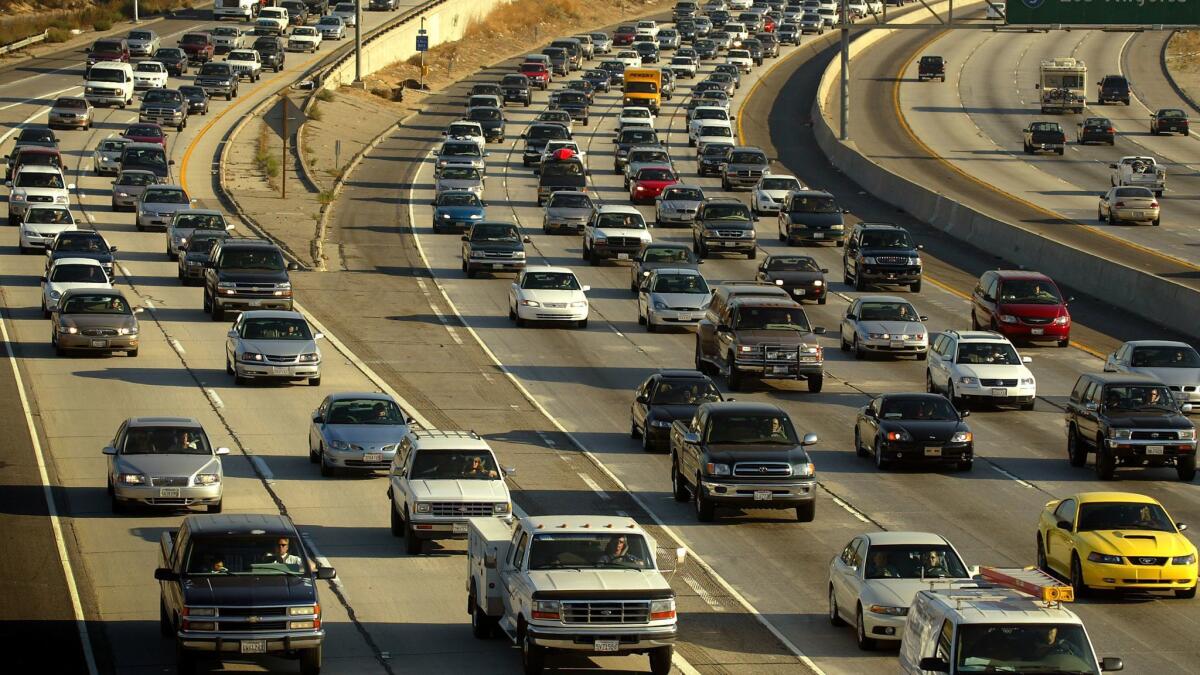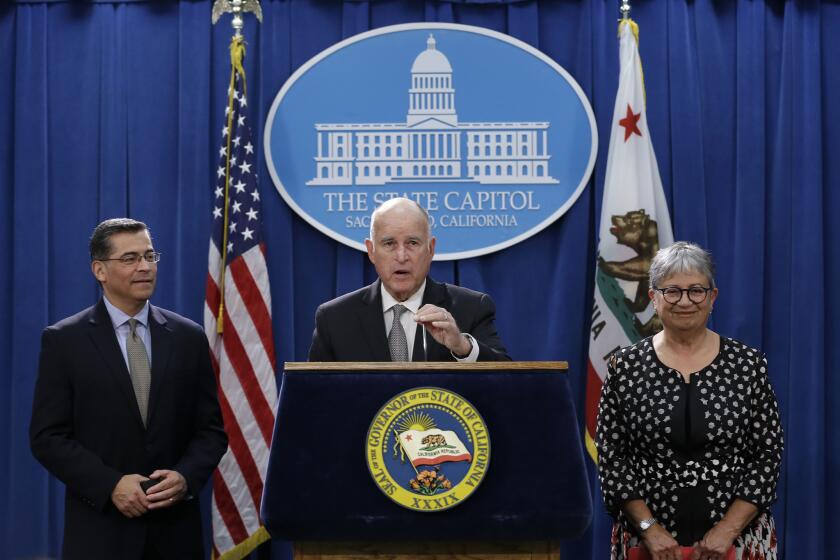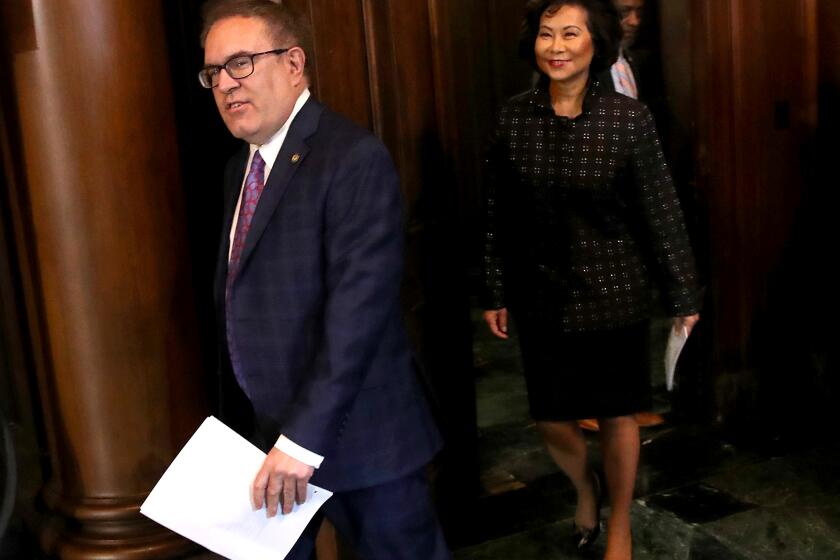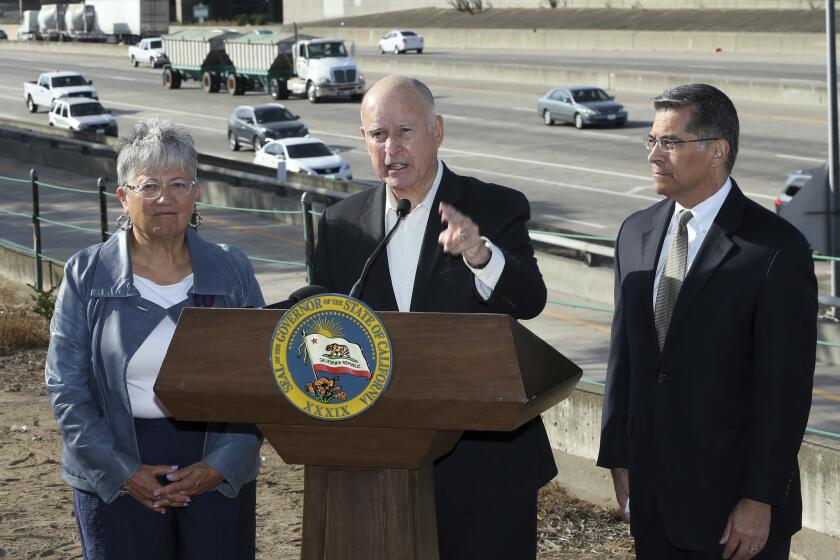Column: No, it’s not your ‘God-given right’ to buy a new gas-powered car

- Share via
For years, automakers have pleaded that, much as they’d love to lead the way to a zero-emissions vehicular future, they just can’t wean Americans from their love of SUVs and other gas-guzzlers.
California just called their bluff.
An executive order signed Wednesday by Gov. Gavin Newsom aims to ban the sale of new gasoline-powered cars and light trucks in the state by 2035.
What we’re sending is a demand signal...The last piece of the puzzle for the automobile manufacturers is that they need the certainty that the demand will be there in the largest domestic auto market in America.
— Gov. Gavin Newsom
The first-in-the-nation policy is far more stringent than anything the state has implemented before. But given that a dozen states accounting for 40% of the American market already conform to California’s auto rules, the policy could spread quickly.
Newsom placed his order firmly in the context of the crisis of climate change, which is on vivid display via California’s ferocious wildfires.
“Why now? With 3.7 million acres burning, to date, after the hottest August in history, a five-year historic drought? Enough — I feel a deep intellectual and emotional need to address this moment head-on by being much more proactive,” Newsom told me.
But let’s not overlook the political context. Newsom’s order is also a shot fired at the nation’s number-one climate change denier, President Trump, whose administration has been rolling back existing emissions standards and has revoked California’s decades-old authority to set its own rules. (Both steps are vulnerable to legal challenge.)
The order takes aim at auto emissions because they’re still the largest single source of air pollution in the state, accounting for nearly 50% of greenhouse gases such as carbon dioxide. Moreover, vehicular emissions have been rising in recent years.
It comes against the backdrop of the split within the auto industry in the battle between Trump and California.
After the administration proposed its rollback of emission rules and the revocation of a waiver granting California the authority to set its own emissions rules, five international automakers — Ford, Honda, BMW of North America, Volkswagen Group of America and Volvo — signed agreements to meet California standards.
Also included in the deal were Rolls-Royce, which was represented by BMW, and Audi, which is owned by Volkswagen.
California’s emissions deal with five key automakers takes aim at Trump environmental rollbacks
The agreement called for the companies to reach average fuel efficiency across their fleets of about 50 miles per gallon by 2026. That’s marginally more lenient than the rules set under the Obama administration which Trump proposed to roll back, but much more demanding than Trump’s proposal, which would freeze the auto mileage standard at 36.9 mpg by 2025.
Several companies, including General Motors, Fiat Chrysler and Toyota, threw in their lot with Trump in the dispute. Newsom calls their position “shameful,” given that they must know that the course of technology is moving inexorably away from the gasoline engine.
“They know better, because they know where the rest of the world is going,” he told me. “It goes to the nature of politics at this moment, and the threat that they’ve received from the Trump administration if they buck him.”
Indeed, while acceding to Trump’s effort to make auto emissions dirtier, some of those companies have launched efforts to electrify their product offerings. GM, for instance, has announced its intention to “make a meaningful impact toward building a zero-emissions future.” Its CEO, Mary Barra, says on the company’s website that “we want to put everyone in an EV, and we believe we have what it takes to do it.”
Despite all that, industry lobbyists and political conservatives wrung their hands over Newsom’s initiative.
“Neither mandates nor bans build successful markets,” groused John Bozella, CEO of the Alliance for Automotive Innovation, an industry group that confirms the impression that the last place to look for real innovation is in any organization or department with “innovation” in its name.
Bozella stepped on his own applause line, however, as he also acknowledged that increasing consumer demand for zero-emission vehicles “will require increased infrastructure, incentives, fleet requirements, building codes and much more” — in other words, mandates and bans.
My favorite response came from the climate change-denying Heartland Institute, a right-wing outfit with ties to the Koch network. Heartland’s commentary sounded like a parody of know-nothing policy: “Real Americans, and all true Californians, love gasoline-powered vehicles,” said Tim Benson, a policy analyst at the institute.
GM, Fiat Chrysler and Toyota, which are siding with Trump in his battle over California emissions rules, are among the worst performing carmakers on emissions.
“This is the state that gave us ... surfin’ woodies, low-riding ’64 Impalas, and the Bullitt chase; songs about little deuce coupes, Bucket T’s, ... old Pasadena biddies hauling ass in shiny red Super Stock Dodges,” Benson continued. “It is every Californian’s God-given right to drive a loud, throaty, ballsy piece of gas-guzzling Detroit muscle.” Never mind that the ‘60s were, er, 60 years ago.
Newsom’s order doesn’t impose a hard stop on sales of gas-powered vehicles, but sets a goal that “100% of in-state sales of new passenger cars and trucks will be zero-emission by 2035.”
At that point, existing vehicles could still be driven in the state and bought and sold in the used car market. Sales of new medium- and heavy-duty trucks and buses would have to meet the 100% zero-emission standard by 2045.
The order gives responsibility for developing the necessary regulations to the state Air Resources Board, which has carried the state’s flag in the emissions battle with the Trump administration. That points to one possible obstacle to executing Newsom’s order: It may require approval from the federal government in the form of a new waiver from the Clean Air Act. That wouldn’t be forthcoming from Trump if he’s reelected.
The auto industry is correct in observing that American consumers have been slow to embrace alternatives to the gasoline engine, much less lead the movement.
As my colleague Russ Mitchell reports, electric vehicles comprised only about 2% of the 17 million cars and light trucks sold in the U.S. last year. In California, which accounts for about half of all domestic EV sales, the share was still less than 10%.
The auto industry mostly blames consumers, citing their concerns about the cost of EVs, the lack of EV charging infrastructure contributing to “range anxiety” (fear of running out of juice miles from a charging station), and contentment with low-priced gasoline.
“Automakers are also victims of our own success” in having made the internal combustion engine “much more efficient across all vehicle segments,” Mitch Bainwol, then the CEO of the Alliance of Automobile Manufacturers, told a House Committee in 2018. That sounds a bit like the old joke about the job candidate who answers an interviewer’s question about his biggest character flaw by saying, “It must be that I’m a perfectionist.”
The truth is, however, that the auto industry is addicted to sales of big, heavy gas-fueled SUVs and pickups, which are only becoming brawnier with every model year.
California’s climate deal with automakers shows the proper solution to Trump is to go around him.
“You can’t turn a page in a magazine or turn on the TV without seeing an ad for a gas-guzzler,” remarks Dan Becker, director of the Safe Climate Transport Campaign at the Center for Biological Diversity. “I understand that — they make a lot of money selling those. The technology is antiquated, it doesn’t cost them very much to make them and they can charge a huge premium.”
Dealers aren’t enamored of EVs, Becker asserts, because they have fewer moving parts than conventional vehicles and therefore could break down less often, which might cut into service department revenue.
“This is not the consumers’ fault,” Becker says, “but the fault of an industry that is continuing to look in a rear-view mirror and not into the future. They have the technology” to build EVs. “They’re missing the will.”
Underlying Newsom’s order is an effort to provide the will. “We have to change the demand paradigm,” he says. “What we’re sending is a demand signal, by definition. The last piece of the puzzle for the automobile manufacturers is that they need the certainty that the demand will be there in the largest domestic auto market in America.”
There’s no reason to doubt that Newsom’s order has the potential to remake the auto market in California and by extension the rest of the country. It doesn’t require of automakers more than they acknowledge they can achieve by 2035.
Auto executives believe the EV market may be on the cusp of exploding, as manufacturers are about to start flooding the market with electrified vehicles along their whole range of offerings.
As the technology matures — especially battery technology, which must improve to give EVs a driving range comparable to gasoline vehicles — EV prices will come down, possibly to the point where they don’t cost significantly more than gasoline vehicles. If and when California’s initiative takes root, charging stations should become almost as ubiquitous as gas stations today.
“There’s going to be an inflection point in the mid-2020s where suddenly people are going to be buying these at a faster rate than anybody expects,” Ken Morris, GM’s EV chief, said as recently as May. With conventional cars and SUVs currently enjoying a lifespan of 10 to 15 years, the shift to zero emissions could be complete by 2050.
That’s how technology often works — the take-up moves slowly, then all at once. The important elements are price, infrastructure and government support, all of which are just over the horizon.
It may even turn out, when we look back at this moment, that California’s vision of a zero-emission car market by 2035 wasn’t overly ambitious, but too modest.
More to Read
Inside the business of entertainment
The Wide Shot brings you news, analysis and insights on everything from streaming wars to production — and what it all means for the future.
You may occasionally receive promotional content from the Los Angeles Times.














